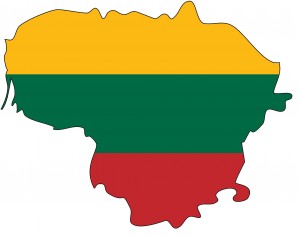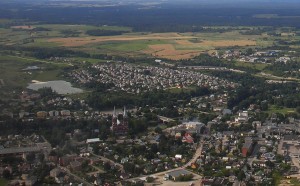Lithuania
Leave a commentLithuania is a small country situated in Northern Europe, the southernmost of the three Baltic states. Situated along the southeastern shore of the Baltic sea, it shares borders with Latvia to the north, Belarus to the southeast, Poland and the Russian exclave of Kaliningrad to the southwest.
You can drive across Lithuania in 5 hours! Its population is 3.2 million. Lithuania may not be the biggest country in the world, but it still has delicious and gorgeous-looking meals, beautiful places to visit and much more!
The colours of the Lithuanian flag have symbolic meaning: yellow stands for the sunshine and light; green is associated with greenness of nature and hope and red is the blood shed by its people who fought for their home.
Anykščiai, Our Hometown
With a population of 11,000, Anykščiai is a small spa resort town in Lithuania, situated 20 miles west of Utena, the county capital. Although the first written mention of the town dates back to 1442, its first appearance on a map is tentatively dated to a much later time, about 1578. Archeological research in the area, however, has revealed settlements dating from the late Neolithic.
Its location by the Šventoji River, connecting it to the Baltic Sea via the Neris River and Nemunas River, contributed to its development. Among the famous locally born people are poet Antanas Baranauskas, writer Antanas Vienuolis, writer Jonas Biliūnas and others. The Roman Catholic Church of St. Matthew in Anykščiai is the tallest church in Lithuania, with spires measuring 79 meters in height. Other famous places like Puntukas stone, the HorseMuseum, the narrow-gauge train and the Museum of Angels annually attract hundreds of tourists from different parts of the country and beyond. Anykščiai was designated the Lithuanian capital of culture for the year of 2012.
ANYKŠČIAI ANTANAS BARANAUSKAS GENERAL SCHOOL
 Situated in the small spa resort of Anykščiai, in the north-east of Lithuania, the school was opened in 1980. The type of school is lower general secondary education. Compulsory education in Lithuania is meant for learners from the age of 7 to the age of 16 covering four years at primary, another two to four in general school and yet another two to four in gymnasium. It is designed to provide a certain level of knowledge, practical skills and culture. The level is defined by educational standards so as to enable learners to cope in various spheres of life in the ever-changing world and to continue studies at a secondary or vocational school. Upper secondary education (for 16-18 year-olds) is not compulsory, but the majority of students stay another two years in an upper secondary school after finishing a six-year general school, wishing to enroll a university or college later.
Situated in the small spa resort of Anykščiai, in the north-east of Lithuania, the school was opened in 1980. The type of school is lower general secondary education. Compulsory education in Lithuania is meant for learners from the age of 7 to the age of 16 covering four years at primary, another two to four in general school and yet another two to four in gymnasium. It is designed to provide a certain level of knowledge, practical skills and culture. The level is defined by educational standards so as to enable learners to cope in various spheres of life in the ever-changing world and to continue studies at a secondary or vocational school. Upper secondary education (for 16-18 year-olds) is not compulsory, but the majority of students stay another two years in an upper secondary school after finishing a six-year general school, wishing to enroll a university or college later.
During their school years, students take examinations twice: after finishing general school and on completion of upper secondary school (gymnasium). After they have passed their chosen exams, students are issued a Certificate of Secondary Education (Maturity) which is necessary for further admission to higher education institutions. Our school houses the two types of schools previously mentioned, which means students may cover primary and lower secondary stages of the educational programme without leaving the same school they are used to. As it is the case with any other school in Lithuania, ours has seen the decline in the number of students for several years. Primarily, this could be accounted on the emigration rate which is still growing due to the economic reasons. Thus, our school only has 640 students today instead of 1,057 students in 2008.
Number of days per week: 5.
Student age range: from 7 to 17.
Number of teaching staff: 65.



Please give us your valuable comment
You must be logged in to post a comment.